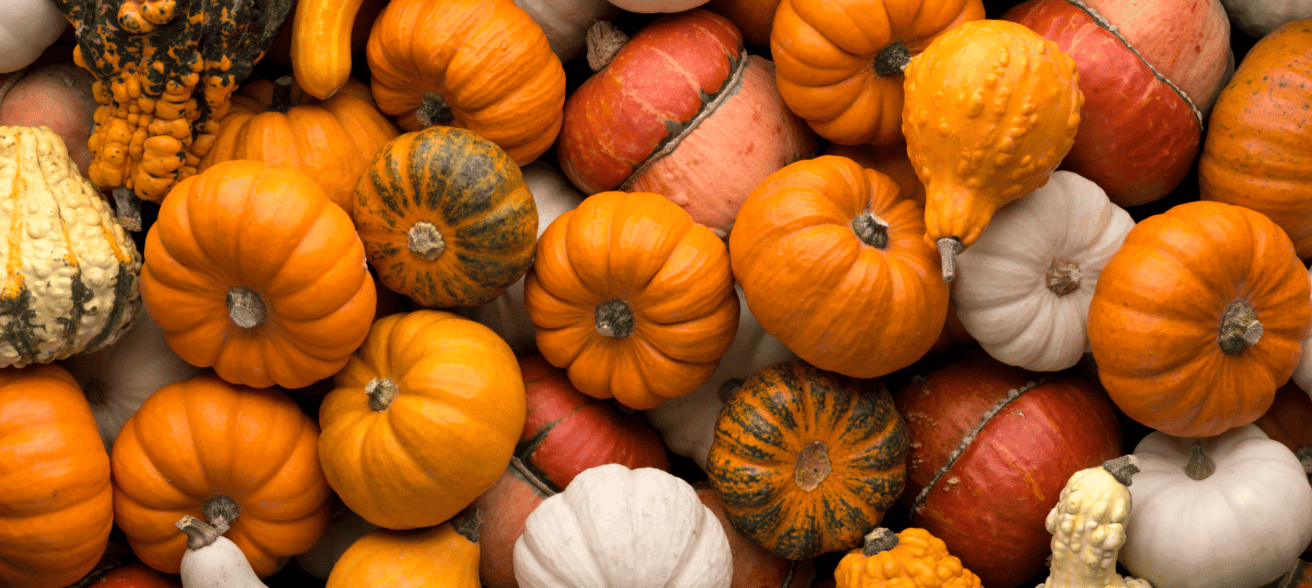Seasonal Spoonfuls: A guide to fall seasonal cooking from the Spoonfuls team

As the air cools down, we’re beginning to see another shift in what’s coming out of the ground on farms here in Massachusetts. We’re savoring our last days with tender vegetables like arugula and chard while welcoming heartier ones like pumpkins and cranberries.
Following up on our summer eating blog, we’ve compiled a list below of in-season Massachusetts food. If you’re interested in eating locally this fall, give it a look! And keep reading for a few recipes around some of our seasonal favorites: pumpkins, pears, and Brussels sprouts.
Fall season food in Massachusetts
- Spinach (May through November)
- Arugula (June through October)
- Bok Choy (June through October)
- Cabbage (June through November)
- Apples (July through April)
- Chard (July through October)
- Peppers (July through October)
- Broccoli (July through November)
- Garlic (July through November)
- Onions (July through November)
- Celery (August through October)
- Leeks (August through mid-November)
- Carrots (August through November)
- Squash (September and October)
- Pears (September through mid-November)
- Cranberries (September through December)
- Pumpkins (September through December)
See more on the Massachusetts-Grown Produce Availability Calendar.

Pumpkin
Pumpkins come in many shapes, sizes, and varieties. Although available year-round as a canned purée, locally grown fresh pumpkin is plentiful (and most economical) in the late fall. Although the whole pumpkin can seem intimidating, it can be an easy and nutritious addition to many dishes. Pumpkins are low-calorie, and a good source of vitamins A and C, and potassium.
Fresh Pumpkin Soup
Ingredients:
- 2 tbsp oil (olive or vegetable)
- 1 onion, diced
- 2 carrots, peeled and diced
- 1 apple, peeled and diced
- 2 cups fresh pumpkin, roasted* and diced
- 1 tbsp dried sage (or 3 tbsp fresh chopped)
- 3 cups chicken or vegetable stock
- 1 cup sour cream
- Salt and freshly ground black pepper
Directions:
- In a large pot over medium heat, add oil, and sauté onion, carrot, apple, roasted pumpkin, and sage until tender, 8 to 10 minutes. Let cool slightly.
- Purée in a food processor, or blender, until smooth (be careful of steam).
- Return purée to pot and add stock. Simmer 15 minutes, stirring often.
- Remove from heat and stir in cream. Taste and season with salt and pepper as needed. Serve warm.
*To roast pumpkin, preheat oven to 400 degrees. Cut whole pumpkin in half and scoop out seeds, then cut each half into several pieces. Reserved seed for another use. Place pumpkin on baking sheet, drizzle with olive oil, and season with salt and pepper. Roast in oven until just tender, about 30-40 minutes. Let cool, peel away skin, and dice.

Pear
Pears come in many varieties, the most common being bosc (brown, soft, and sweet), anjou (green or red and crisp), and bartlett (also green, mild, and crisp). Pears are a good source of fiber and vitamin C. They have a very small core of seeds, making them easy to eat on the go!
Cauliflower and Pears with Sage & Hazelnuts
Ingredients:
- 6 tbsp unsalted butter
- 1 medium head cauliflower, cut into small florets
- ½ cup hazelnuts, chopped & toasted
- 8 fresh sage leaves, thinly sliced crosswise (or 1 tbsp dry rubbed)
- 2 large ripe pears, cored and coarsely chopped
- Sale & pepper to taste
- 2 tbsp chopped fresh flat-leaf parsley (optional)
Directions:
- Preheat oven to 350 degrees. Toast hazelnuts: spread in a single layer on a baking sheet and bake 10-15 minutes, stirring every 5 minutes, until lightly browned.
- In a medium skillet over medium-high heat, cook butter until light brown and bubbly. Add the cauliflower, hazelnuts, and sage. Cook, occasionally stirring, until cauliflower is browned and just tender, 8-10 minutes.
- Remove the pan from the heat and gently toss in pear. Season with salt and pepper to taste. Top with parsley (optional) and serve.

Brussels Sprouts
Brussels sprouts are part of the Brassica family of vegetables, along with broccoli and cabbage. They resemble mini cabbages and grow on a tall stalk. They taste similar to cabbage, and can sometimes be bitter without seasoning. They are low in calories and a good source of fiber and vitamin C.
Lemon Garlic Pasta with Brussels Sprouts
Ingredients:
- 1 lb Brussels sprouts
- ½ lb dry pasta (any shape)
- 2 tbsp (olive or vegetable)
- 1 clove of garlic, minced
- ¼ tsp chili flakes (optional)
- ½ cube chicken or vegetable bouillon
- ½ lemon
- Parmesan (for serving)
Directions
- Rinse and time Brussels sprouts and slice them thinly (or shred in a food processor or mandolin).
- Cook pasta according to the package. Drain, reserving ½ cup of cooking liquid for later. Meanwhile, heat oil over medium heat in a large sauté pan. Add in Brussels sprouts, along with a pinch of salt and red chili flakes (if using). Sauté until tender or lightly golden, 2 or 3 minutes.
- Add pasta, cooking liquid, and bouillon to Brussels sprouts, stirring until reduced to a light sauce, 5 or 6 minutes. Squeeze 2 to 3 tsp of lemon juice over the top, stir, and season with slate and pepper to taste. Top with Parmesan to serve.
Related posts:
Seasonal Spoonfuls: Winter
Seasonal Spoonfuls: Spring
Seasonal Spoonfuls: Summer